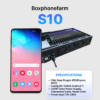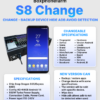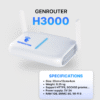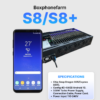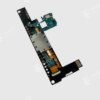In the world of MMO (Make Money Online) and Digital Marketing, the concept of a “phone farm” is no longer foreign. This is a powerful “weapon” that helps automate a series of tasks, from nurturing social media accounts, playing games, running ads, to implementing large-scale seeding campaigns. However, the effectiveness of an entire phone farm system depends heavily on the core factor: the phones themselves. Choosing the wrong device not only wastes investment costs but also leads to poor performance, unstable operation, and even complete failure. So, how do you choose the “perfect” phone for your farm? What are the golden criteria to consider? In this in-depth article, GenFarmer will analyze everything from A-Z, from configuration, operating system, to whether to buy new or used devices, helping you make the smartest and most optimal investment decision.
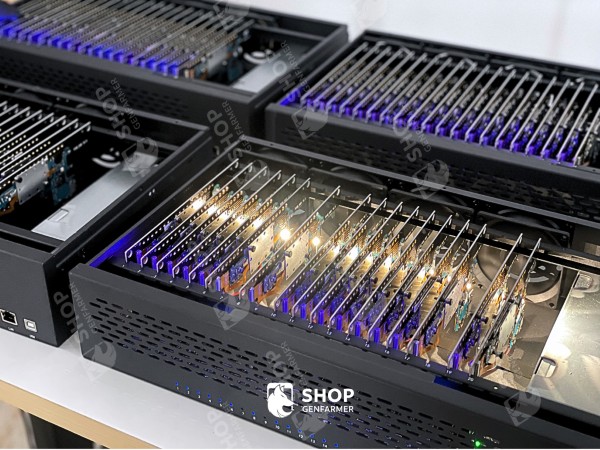
1. Important criteria when choosing phones for farming
To build a phone farm system that operates smoothly, durably, and effectively, choosing a phone cannot be based on intuition or cheap prices alone. Every component of a smartphone plays a crucial role, directly affecting work performance. Below are 4 core criteria you cannot ignore.
1.1. RAM & ROM: How much is enough?
RAM (Random Access Memory) and ROM (Read-Only Memory – internal storage) are the first two specifications to consider. They determine the device’s multitasking capabilities and storage space.
- RAM: This is the buffer memory that allows the phone to run multiple applications at the same time. When farming, you will need to open multiple accounts simultaneously, run automation tools, and perform background tasks. Low RAM will cause stuttering, lagging, and application crashes, interrupting the automation process.
→ Suggestion: The minimum RAM should be 4GB. With this amount of RAM, you can run basic tasks stably. However, to ensure the best performance for more complex jobs, GenFarmer recommends choosing a device with 6GB of RAM or more. - ROM: This is where the operating system, applications, and all data generated during the “grinding” process (cache, account data, media files…) are stored. If the ROM is too low, it will quickly fill up, forcing you to spend time cleaning it constantly, and you may not even be able to install necessary applications.
→ Suggestion: The minimum ROM should be 64GB. This amount is sufficient if you use a stock Android operating system or lightweight custom ROMs. For those with large storage needs, it is better to prioritize 128GB or 256GB versions to have a comfortable workspace.
1.2. Operating System: Choose stock Android, easy to root, easy to control
The operating system (OS) is the soul of the phone. For a phone farm, Android OS is the only choice thanks to its openness and deep customization capabilities. However, not all versions of Android are the same.
- Stock Android: Devices using stock Android (like Google Pixel) or near-stock Android usually do not contain bloatware from the manufacturer. This helps the device run lightly, smoothly, and saves system resources (RAM, CPU) for farming tasks.
- Rooting and Customization Capabilities: “Rooting” is the process of gaining the highest level of control over an Android device. This opens up countless possibilities: installing custom modules, changing device information, faking IP, removing unnecessary system applications… This is almost a mandatory requirement for professional MMO earners. Therefore, prioritize devices with large community support, making it easy to find guides and tools for rooting. Older Samsung models are often the top choice for this reason.
1.3. Price: Optimize performance/price → no need for the latest flagships
The goal of a phone farm is to maximize profit, so the initial investment cost is an important calculation. Chasing the latest flagship (high-end) models is an unnecessary waste. A new phone costing 20-30 million VND does not provide significantly higher farming efficiency than an old device costing only 1/5 – 1/10 of the price.
Instead, the smart strategy is to focus on the performance/price ratio. Older flagship models (from 2-4 years ago) are often the golden choice. They have chips that are still very powerful, sufficient RAM/ROM, and most importantly, their prices have dropped significantly. This is the sweet spot for optimizing investment costs.
1.4. Stability for 24/7 operation: needs a chip with good heat dissipation, few crashes
A phone farm is designed to operate continuously, 24 hours a day, 7 days a week. Therefore, stability is a vital factor. A farm that frequently freezes or reboots will cause heavy losses in productivity and revenue.
- Chipset and Heat Dissipation: During continuous operation, the chipset will generate a large amount of heat. If not dissipated well, the device will experience “thermal throttling” – automatically reducing performance to lower the temperature, leading to lag. In more severe cases, it can cause the device to freeze or damage components. Therefore, it is advisable to prioritize devices that are highly rated for their temperature management capabilities.
- Software Stability: Choosing devices with a stable stock ROM or well-developed custom ROMs will minimize the risk of software-related minor errors.
2. Should you choose new or used phones for a phone farm?
This is a classic question that anyone starting a phone farm must face. Each choice has its own advantages and disadvantages, suitable for different scales and investment strategies.
2.1. Advantages of used phones: Cheap, easy to buy in bulk, suitable for large-scale farms
For the majority of farmers, especially those building large-scale systems (from tens to hundreds of devices), used phones are almost the only option.
- Extremely low cost: This is the biggest advantage. The price of an old flagship phone (2-3 years old) is only a fraction of a new one, helping you save a huge amount of investment capital.
- Easy to buy in bulk: The supply of used phones is very abundant, allowing you to easily find and buy tens or even hundreds of the same model to ensure uniformity for the entire farm.
- Optimized ROI: With low initial costs, the return on investment (ROI) time will be significantly shortened.
2.2. Disadvantages of used phones: Worn-out battery, risk of motherboard failure, need to be tested thoroughly before farming
However, “you get what you pay for.” Along with the cheap price come potential risks that you need to anticipate:
- Worn-out battery: This is the most common issue. The battery of a used phone has often been used for a long time, so it no longer holds a good charge. However, in a phone farm environment where devices are plugged in 24/7, this issue is not too serious.
- Risk of hardware failure: Used phones have a higher risk of breaking down, especially issues related to the mainboard, screen, and charging port. A few faulty devices in the farm might be acceptable, but a high failure rate will greatly affect overall operations.
- Requires testing experience: To minimize risks, you or your supplier need to have the experience to thoroughly test (full-function test) each device before putting it into operation.
2.3. What are the benefits of new phones?
Buying 100% new phones for a farm is usually only for businesses with abundant budgets or individual users who only need a few devices.
- Durability and stability: New phones are 100% guaranteed in terms of components and battery, and come with an official warranty, providing absolute peace of mind during use.
- Easy to manage in bulk: When you buy a batch of new phones, you ensure that they are all identical in terms of hardware and software, making setup and management easier.
- Long-term update support: New phones will be supported by the manufacturer with software updates and security patches for many years.
2.4. Suggestion: Reusing high-end older flagship phones (S9–S21) is the most optimal choice
After considering all the factors, GenFarmer concludes that the most optimal choice for most phone farm models is to use older Samsung flagship lines, specifically from the Galaxy S9 to the Galaxy S21.
The reason is that these models converge all the golden factors:
- Performance is still very powerful: The Exynos or Snapdragon chips in these models are fully capable of handling all farming tasks.
- Extremely reasonable price: Their prices are now very good, creating an unbeatable performance/price ratio.
- Large support community: It is easy to find custom ROMs, root guides, support tools, etc.
- Good hardware quality: As high-end models, they are equipped with durable components, beautiful screens, and better heat dissipation capabilities than cheap models.
3. Samsung phone lines at GenFarmer
At GenFarmer, we not only provide software solutions and box phone farms but also directly select and distribute phone lines that have been thoroughly tested and optimized, ready for farming. Below are the popular models and the special “Change” models developed by us.
3.1. List of popular phone farming devices at GenFarmer
These are the “workhorses” that have been trusted by the farming community for many years thanks to the perfect balance of performance, stability, and price.
| Product Name | CPU (GHz) | GPU | Chipset |
|---|---|---|---|
| Samsung Galaxy S8/S8+ | 2.45 GHz (8 cores) | Adreno 540 | Snapdragon 835 |
| Samsung Galaxy S9/S9+ | 2.8 GHz (8 cores) | Adreno 630 | Snapdragon 845 |
| Samsung Galaxy S10/S10+/S10e | 2.84 GHz (8 cores) | Adreno 640 | Snapdragon 855 |
| Samsung Galaxy S20/S20+/S20 Ultra | 2.84 GHz (8 cores) | Adreno 650 | Snapdragon 865 |
| Samsung Galaxy S21 FE | 3.2 GHz (8 cores) | Adreno 650 | Snapdragon 870 |
| Samsung Galaxy S21/S21+/S21 Ultra | 2.84 GHz (8 cores) | Adreno 660 | Snapdragon 888 |
| Samsung Galaxy S22/S22+/S22 Ultra | 3.0 GHz (8 cores) | Adreno 730 | Snapdragon 8 Gen 1 |
| Samsung Galaxy S22 Ultra/Z Flip 4/ Z Fold 4 | 3.2 GHz (8 cores) | Adreno 730 | Snapdragon 8+ Gen 1 |
3.2. List of “Change” models at GenFarmer
Understanding the specific needs of MMO professionals, GenFarmer has taken it a step further: developing the “Change” series. These are old Samsung flagship phones that we have improved with custom ROMs and in-depth upgrades, turning them into true farming machines with superior performance and control compared to the original devices.
3.2.1. Samsung Galaxy S8 Change
- Uses Android 14 to ensure the device runs smoothly with all modern applications such as TikTok, Facebook, Instagram, etc.
- Custom ROM – Optimized for stealth supports: completely hiding ADB to avoid being scanned and detected by platforms when running automation; changing fingerprint, build ID, device info, making the device appear as a real device on the market; bypassing the security systems of TikTok, Facebook, etc., to minimize checkpoints, login blocks, and action limits. These are things that the original S8 cannot do.
- Optimized for continuous 24/7 operation to ensure smooth operation throughout the day, save power, and prevent unexpected freezes or reboots.
3.2.2. Samsung Galaxy S10 Change
- 8GB RAM – 128GB ROM: No more worrying about freezes or app crashes when running multiple accounts at the same time.
- Equipped with a Snapdragon or Exynos chip for more stable operation than the S8 in heavy tasks such as gaming, airdrops, etc.
- Uses Android 14 to ensure the device runs smoothly with all modern applications such as TikTok, Facebook, Instagram, etc.
- Custom ROM – Optimized for stealth supports: completely hiding ADB to avoid being scanned and detected by platforms when running automation; changing fingerprint, build ID, device info, making the device appear as a real device on the market; bypassing the security systems of TikTok, Facebook, etc., to minimize checkpoints, login blocks, and action limits.
- Optimized for continuous 24/7 operation to ensure smooth operation throughout the day, save power, and prevent unexpected freezes or reboots.
3.2.3. Samsung Galaxy Note 10 Lite Change
- Exynos 9810 chip as powerful as the Galaxy S10 and 6GB RAM, 128GB ROM help the device run smoothly with all AI automation, behavior-based, and heavy games like Lineage 2M, Ymir, etc.
- Industrial-grade stability allows the device to operate continuously 24/7 smoothly, without lag.
- Stock ROM + deep KernelSU processing: Completely hides root, ADB, and bypasses almost all scanning mechanisms of TikTok, Facebook, Instagram.
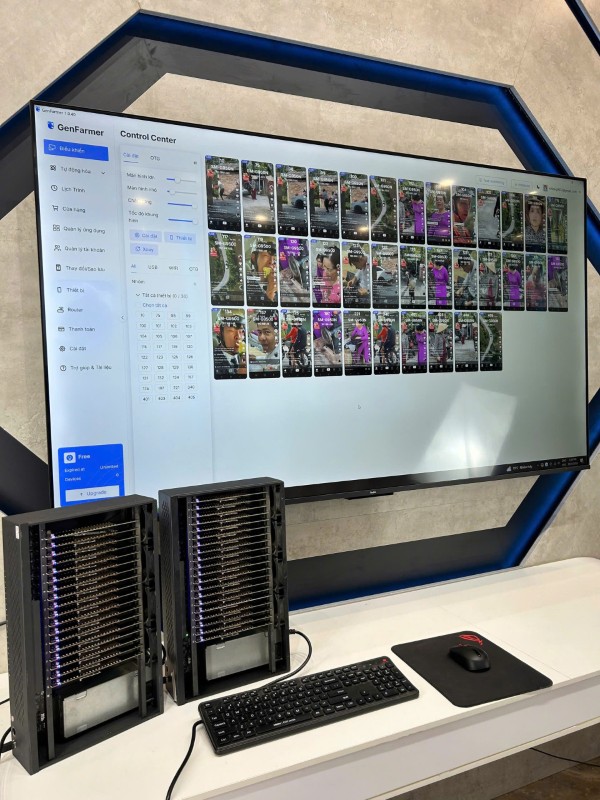
Conclusion
Choosing a phone is a fundamental step that determines 50% of the success of a phone farm project. A correct choice will help you save costs, optimize performance, and operate the system smoothly and durably. Always remember the core criteria: sufficient RAM/ROM (minimum 4GB/64GB), an easily customizable Android operating system, high stability for 24/7 operation, and a reasonable price.
At GenFarmer, we don’t just talk about theory. We provide practical solutions. From consulting to help you choose the right phone model for your needs and budget, providing quality-tested devices, to exclusive “Change” models and comprehensive box phone farm systems and management software.
Don’t let the wrong choice of phone hinder your path to success. Contact GenFarmer today for consultation and to build the most professional and effective phone farm system!







